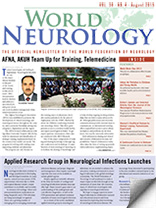By John D. England, MD

John D. England
The editorial staffs of the Journal of the Neurological Sciences (JNS) and our publisher, Elsevier, have strived to enhance the quality of the journal. I am pleased to inform you that Elsevier soon will introduce the Journal Workflow Modernization Programme. This new workflow program, which Elsevier has named LeMans, will result in authors receiving proofs of their articles within 24 to 72 hours after acceptance. The LeMans program will significantly decrease the production time for all of our accepted articles. As an editor, I know that authors desire to see their articles published as quickly as possible, and this new feature will accelerate the publication process.
Additional steps for enhancing publication such, as the introduction of Article-Based Publishing (ABP) are planned. ABP, which should be introduced in late 2015, will post articles online as soon as they are finalized without waiting for an entire journal issue to be compiled.
All of these advancements reflect the ongoing transition from print to electronic publishing. JNS, like many Elsevier journals, is moving quickly toward a totally electronic publishing platform.
In our ongoing attempt to enhance accessibility of JNS articles for members of the World Federation of Neurology (WFN), we have selected two more free-access articles, which are profiled in this issue of World Neurology.
- Stephanie Brown and Andrew Stanfield provide an excellent review of the fragile X tremor ataxia syndrome (FXTAS), which is an increasingly recognized movement disorder. Affected individuals carry the permutation allele of the FMR1 gene. This permutation is an expansion of the nontranslated 5′ CGG repeat region of FMR1 from the normal range, which is less than 45 repeats to between 55 and 200 repeats. Affected individuals are usually men over 50 years of age who have progressive symptoms of tremor, ataxia and cognitive decline. Other manifestations include Parkinsonism, peripheral neuropathy, autonomic dysfunction and endocrine changes. The authors detail the clinical, molecular and neuroimaging manifestations of the disease. They emphasize the neuroimaging characteristics of FXTAS, which include increased T2 signal intensity in the middle cerebellar peduncle (MCP sign), thinning of the corpus callosum and white matter atrophy.
- Alexander Slade and Sinisa Stanic reviewed the literature regarding the usefulness of salivary gland irradiation for managing sialorrhea in patients with amyotrophic lateral sclerosis (ALS). Many patients with ALS have difficulty controlling salivary secretions. Although oral anticholinergic medications or botulinum toxin injected into the salivary glands can be helpful, patient intolerance or unacceptable adverse effects may occur. This review concludes that the majority of ALS patients with sialorrhea respond well to salivary gland irradiation and experience minimal side effects. Thus, clinicians should consider this treatment option for patients with ALS who are troubled by excessive salivation.
